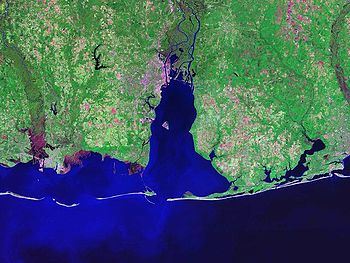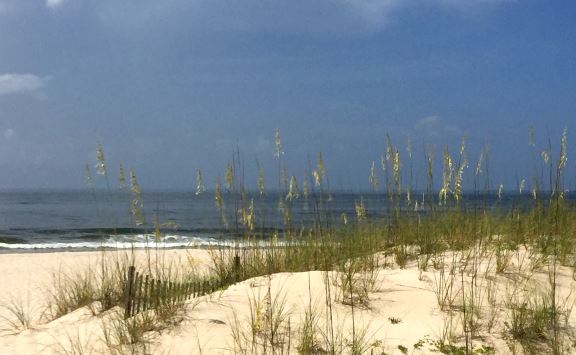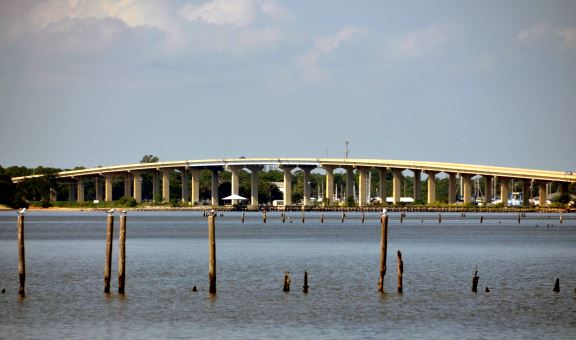The Legend of Prince Madoc
By Gary Wright
The hardest thing of all is to find a black cat in a dark room,
especially if there is no cat. – Confucius
Mobile, Alabama is replete with history and tradition. Reputedly, the birthplace of Mardi Gras in North America, it was, indeed, a major shipping port during the Civil War. Rich in tradition of fine cuisines of seafood and barbecue, the eastern shore of Mobile Bay is home to the ‘jubilee’ which is a phenomenon where shrimp, fish and other sea creatures rush onto shore and are quickly harvested by gleeful people who load up tubs of fresh, free seafood. Nothing, however, can quite match the legend that Prince Madoc of Wales landed in Mobile Bay around 1170 AD.

Mobile Bay Map
History, naturally, tends to be written by historians, but seldom by geographers, or seamen, or interpreters of legend. Much of the early history of the world has suffered in consequence because historians were never present at the events described and usually they have their own pre-determined interpretation of history or similar ax to grind. In other words, they must fit their writings into the molds of what is already thought to be known and not what is necessarily the truth. People who witness the actual events seldom have a hand in writing history, therefore written history usually reads like a manual that has been put together by a committee of technical experts two or three times removed from the actual event.
It is said that in 1170 AD., a Welsh prince, Madoc ab Owain Gwynedd, sailed away from his homeland, which was filled with war and strife. Yearning to be away from the feuds and quarrels, he took his ships and headed west, seeking a better place. By and by he returned to Wales, brimming with tales of the new land he had found — warm and golden and fair. His tales convinced many of his countrymen and they left with him to return to this wondrous land, far across the sea. Nothing was ever heard of them again. This new land is believed to have been in the ‘New World,’ specifically in what is now Mobile Bay, Alabama. Time has left several blank pages between the legend of Madoc and the “history” of America, with its reports of white Indians who speak Welsh. In order to conform to the norm of historians, these blank pages have been the subject of controversy in certain circles over the five centuries since Columbus ‘discovered’ the New World.

Mobile Bay at Fairhope, Alabama
There is a letter on file at the Georgia Historical Commission, which recounts a 1782 conversation that then-Governor of Tennessee John Sevier had with 90-year-old Oconosoto, a Cherokee Native American, who had been the chief of the Cherokee Nation for nearly sixty years. Sevier had asked the Chief about the people who had left certain mysterious “fortifications” in his country. The old chief recounted an oral Cherokee folk story: “They were a people called Welsh and they had crossed the Great Water.” He said that tradition called their leader “Modok.”
Although several tribes have been considered as possible descendants of the Welsh settlers, the most likely is the Mandan tribe, who once inhabited villages along tributaries of the Missouri River. Today, the beach on the Gulf of Mexico where Madoc may have landed is called Gulf Shores. It is in Alabama that Prince Madog landed on ‘a dazzling beach, the sand white as snow, sparkling in the sun, the sea blue as the sky and clear,’ according to Welsh tradition.

Gulf Shores, Alabama
At various times, several real Indian tribes and other imaginary ones were said to have been blue-eyed, Welsh-speaking Indians. Eventually, the Mandan of North Dakota became the most favored tribe, because their dwellings, their social structure and their pale skin and blue eyes differed from those of their more nomadic neighbors.
In November 1953, The Daughters of the American Revolution even went so far as to erect a bronze tablet at Fort Morgan, in Mobile Bay that reads: “In memory of Prince Madoc, a Welsh explorer, who landed on the shores of Mobile Bay in 1170 and left behind, with the Indians, the Welsh language.” In 1979 it was blown down by Hurricane Frederick and the Director of the Fort Morgan Museum refuses to this day to allow the plaque to be put back. You see, he is politically correct and conforms to the norm of the classical historian.
There is a large and important river which empties into Mobile Bay near Mobile. It is the Dog River. When the first Europeans came to the area the natives called it the Mad-Dog River. The term ‘mad-dog’ means absolutely nothing in any language except English. Could it have been modified over time from ‘Madoc’ to ‘Mad-Dog’ to simply ‘Dog?’ Some Mobilians, however, still refer to that river as the Mad-Dog River. If any of this is true, then Prince Maddog was indeed a notable adopted Southerner.

Mad Dog River Bridge at Mobile
If it is not true, then you may have simply been waltzed down a happy tale of mystical, magical whimsy. But who am I to say? I am merely the purveyor of information. It is for you to determine what is fancy and what is fact. “History is what it was; not what historians say that it was.”
Fairhope Image: commons.wikimedia.org
Mobile Bay Map Image: en.wikipedia.org
Gulf Shores Image: Deborah Fagan Carpenter
Mad Dog River Bridge at Mobile: Wikimedia Commons


